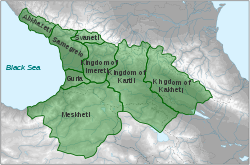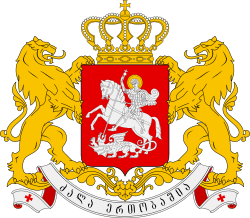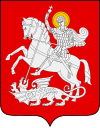Kingdom of Kartli
The Kingdom of Kartli (Georgian: ქართლის სამეფო, kartlis samepo) was a late medieval/early modern monarchy in eastern Georgia, centred on the province of Kartli, with its capital at Tbilisi. It emerged in the process of a tripartite division of the Kingdom of Georgia in 1478 and existed, with several brief intervals, until 1762 when Kartli and the neighbouring Georgian kingdom of Kakheti were merged through dynastic succession under the Kakhetian branch of the Bagrationi dynasty. Through much of this period, the kingdom was a vassal of the successive dynasties of Iran, but enjoyed intermittent periods of greater independence, especially after 1747.
Kingdom of Kartli ქართლის სამეფო kartlis samepo | |||||||||
|---|---|---|---|---|---|---|---|---|---|
| 1478–1762 | |||||||||
 Coat of Arms according to Prince Vakhushti's Atlas (c.1745)
| |||||||||
 Kingdom of Kartli in 1490 | |||||||||
| Capital | Tbilisi | ||||||||
| Common languages | Georgian | ||||||||
| Religion | Georgian Orthodox Church | ||||||||
| Government | Kingdom | ||||||||
| King | |||||||||
• 1478–1505 | Constantine II (first) | ||||||||
• 1744–1762 | Teimuraz II (last) | ||||||||
| Historical era | Early modern period | ||||||||
• Established | 1478 | ||||||||
• Subject of Persia | 1555-1747 | ||||||||
• Union of Kartli and Kakheti | 1762 | ||||||||
| |||||||||
| Today part of | |||||||||
| History of Georgia |
|---|
 |
|
Middle Ages
|
|
Early modern history |
|
Modern history |
|
History by topic |
|
|
Historical Overview
Disintegration of the Kingdom of Georgia into Warring States
From circa 1450, in the Kingdom of Georgia rival movements arose among competing feudal factions within the royal house and nobility. These caused a high degree of instability across the entire territory of the kingdom. This period was characterised by feudal competition, separatism, and civil war.
Major disintegration of the Georgian kingdom dates from 1463 with the defeat of George VIII at the Battle of Chikhori by the rebellious nobleman Bagrat. The latter destroyed any outward vestige of Georgian national unity by proclaiming himself the King of Imereti. This move led to the beginning of the wholesale disintegration of the former united Georgian monarchy and state. This devolution was to be repeated in various forms for rest of the collective history of this region.
In the aftermath of his 1465 defeat, George VIII was captured by Qvarqvare II Jaqeli, Prince of Samtskhe (Meskheti). Sensing an opportunity, Bagrat VI crossed the borders of East Georgia (inner Kartli) and proclaimed himself King of all Georgia in 1466.
Qvarqvare, fearing that Bagrat was gaining too much power, released George VIII from captivity, but the deposed king was unable to reclaim his former crown. He only managed to proclaim himself King of Kakheti, a rump state. This left Lower Kartli to his nephew, Constantine, another pretender to the throne. Constantine established himself as a de facto ruler over part of Kartli in 1469, challenging Bagrat's hegemony.
Bagrat VI continued to rule Kartli until 1478, when he was again challenged by Constantine.
Developments in Western Georgia
Alexander son of Bagrat VI retired to the mountainous western provinces of Racha and Lechkhumi, from which he tried to ascend the throne of Imereti. He summoned "Dadiani, Gurieli, Sharvashidze and Gelovani" to attend his coronation, but headed by Vameq II Dadiani, the latter refused to support him and instead invited Constantine to Western Georgia.
With the help of the local dukes, Constantine took Kutaisi and briefly restored the integrity of Kartli with Western Georgia. In 1481, Constantine managed to subordinate Samtskhe and thus proclaimed himself King of All Georgia.
Rival factions, however, continued to struggle to gain the upper hand.
In 1483, Qvarqvare II declared war on Constantine and defeated the royal forces at Ardeti. In 1484, the demoted former heir, Alexander, proclaimed himself king of Imereti (Western Georgia). Meanwhile, the new feudal overlord of Odishi - Liparit II Dadiani invited Constantine II to West Georgia for a second time.
In 1487, Constantine went to Imereti, but had to abandon the campaign when in 1486 [date problem] a Turkmen chieftain, Yaqub b. Uzun Hasan invaded Kartli and the king was forced to deal with the threat his incursion posed.
Alexander took advantage of this and captured Kutaisi and restored his authority in Imereti. Next, the king of Kartli effected a temporary reconciliation with the kings of Kakheti and Imereti, and the prince of Samtskhe, thereby forming the outright long-term division of Georgia into petty kingdoms and principalities.
Later developments
These new realms were not long at peace. Soon after coming into power, George II of Kakheti launched an expedition against Kartli, intending to depose King David X and conquer his kingdom. David's brother Bagrat successfully defended the kingdom and managed to capture George II in an ambush.
Peace did not survive long in the west either, as David X faced incursions from Alexander II of Imereti, who was somewhat less successful than his Kakhetian counterpart.
In 1513, the Kingdom of Kartli managed a short conquest of neighbouring Kakheti. In 1520, the Kingdom of Kakheti was restored with the support of local nobles by Levan of Kakheti, son and heir of George II.[1]
The Peace of Amasya (1555) recognized Kartli, Kakheti, and eastern Samtskhe as Persian possessions, while everything to the west of it (i.e. Imereti, western Samtskhe) fell into Ottoman hands. During the next two centuries, Kartli was an integral part of the empire of successive dynasties of Persia. It regularly paid tribute and sent gifts (pīškeš) to the shah in the form of boys and girls for use as slaves; horses; and wines, thereby losing its true sovereignty.[2]
Eighteenth Century: Georgian petty kingdoms under Persian and Ottoman Vassalage
In 1747, the Shah of Persia, Nader Shah was assassinated. Capitalizing on this instability Teimuraz II and his son Heraclius II, who had been given the kingship of Kartli and Kakheti respectively by Nader Shah himself as a reward for their loyalty, declared their de facto independence from Persia.
After Teimuraz II's death in 1762, Irakli II assumed control over Kartli, thus unifying the two into the short-lived Kingdom of Kartli-Kakheti.
Extinction of Georgian Quasi-Independence and Integration into the Russian Empire
Following the Treaty of Georgievsk (1783) and Agha Mohammad Khan Qajar's brief re-occupation of eastern Georgia, the Kingdom of Kartli-Kakheti was annexed by the Russian Empire in 1800. The former warring royal houses of the various Georgian kingdom were mostly incorporated into the Russian nobility, thereby losing their quasi-royal status, and becoming subsumed into the Russian empire's service nobility.
Russian control over Kartli-Kakheti was finalized with Qajar Iran by the Treaty of Gulistan of 1813.[3]
References
- Georgian Soviet Encyclopedia, Vol. 10, pg. 466–469, Tb., 1986
- Berdzenishvili, ed., 1973, pp. 252–254
- Timothy C. Dowling Russia at War: From the Mongol Conquest to Afghanistan, Chechnya, and Beyond p 728 ABC-CLIO, 2 dec. 2014 ISBN 1598849484

